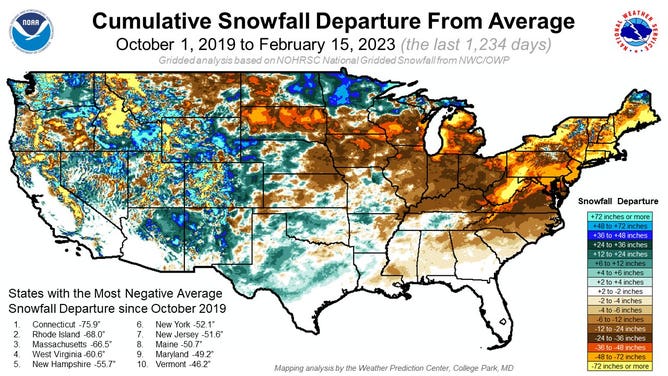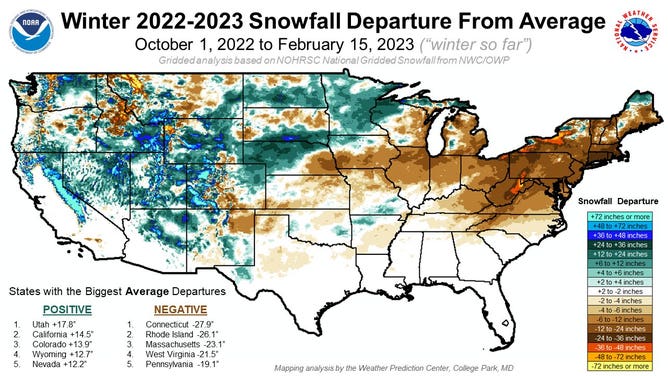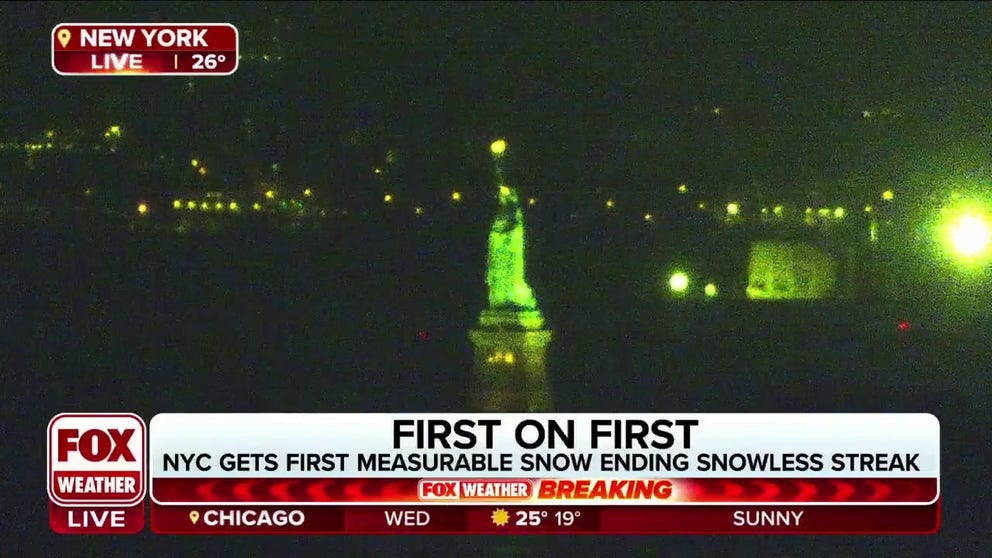Here's how many Northeast winters have been lacking snow
Those in the coastal Northeast already know the snow has been hard to find this winter -- particularly along the I-95 corridor where some records have been broken for longest waits for first snow and seasonal snowfall totals remain well below average. But it's not just this winter, many of the past several winters have bee below average.
NYC records latest first measurable snowfall, ending snowless streak this winter
Central Park recorded the first measurable snowfall of the season Wednesday morning. This is latest first measurable snowfall for the season since record keeping began in 1869.
Those in the coastal Northeast already know the snow has been hard to find this winter -- particularly along the I-95 corridor, where some records have been broken for the longest waits for first snow, and seasonal snowfall totals remain well below average.
But lack of snow in the eastern half of the country hasn't just been a 2022-23 winter theme, it's been the theme for the past four winters.
A new analysis by the National Weather Service's Weather Prediction Center shows significant overall snow deficits across the Great Lakes, Mid-Atlantic and even part of the upper Midwest.
"Northeast and Great Lakes snow fans, look away!" WPC forecasters tweeted while releasing the maps.
Heavy snowfall deficits of 5 feet or more stretch into Pennsylvania and West Virginia, and even western Michigan. Widespread snow deficits of 1-3 feet cover the Carolinas and the southern Great Lakes area into the Ohio Valley.

Departure from average snowfall for U.S. between 2019 and 2023.
(NOAA)
But nowhere is the deficit as bleak as New England, where four-year snow deficits reach at least 4 feet, with many areas at 6 feet or more. That's despite occasional winter storms over the past four years mixed in, such as the Blizzard of '22.
In fact, the WPC analyzed the cumulative snowfall deficit by state since Oct. 2019, and 8 of the top 10 are in New England, topped by Connecticut at nearly 76 inches below average.
Four of the past five winters in the region have featured below-average snow totals. Central Park gets about 25-30 inches of snow a winter, but only 2020-2021 has reached that mark (38.6 inches) since 2017-2018.
HOW TO WATCH FOX WEATHER ON TV

Snowfall Departure from Normal in winter of 2022-23
(NOAA)
But the current winter has been a significant contributor to the deficit, with much of the Northeast 1-3 feet below normal. This season, New York City has a paltry 0.4 inches of snow, which, as it stands, would be the least snowy winter on record. And those records stretch back to 1867.
NEW YORK CITY ARGUABLY HAS THE MOST UNIQUE WEATHER OBSERVATIONS IN AMERICA

People enjoy an afternoon in Central Park in Manhattan on an unseasonably warm afternoon on February 15, 2023 in New York City.
(Spencer Platt / Getty Images)
Again, Connecticut tops the chart for the state with the largest deficit of nearly 28 inches just this winter.
About the only spots in the region where snowfall is well above average this winter are where the two major lake-effect snowstorms pummeled western New York and the northern edge of Maine.
With the dearth of snow in the East, the national snow cover sat at just 31.5% on Jan. 1, its lowest level since 2012.
Snow has been hanging out West
If you're looking for where all the snow went, it's in the West this winter and across the far Northern Plains.
The stubborn weather pattern this winter has been for large troughs to form in the West, bringing lots of stormy, wintry weather.
But persistent ridges of high pressure along the East Coast have shuttled the storms northeast through Minnesota and northern Wisconsin into Michigan's Upper Peninsula and southeastern Canada, clipping the northern tip of Maine and leaving the rest of New England either dry or when moisture does come along, it's mostly rain.
HERE'S WHY THE U.S. HAS THE LOWEST SNOW COVER IN OVER A DECADE
On the other hand, much of the Rockies and some of the upper Midwest are running about a foot ahead of average, though California's Sierra Nevada and the peaks of the Rockies are running 6 feet or more above average in some spots.
Yet when averaged against the past four years, it's a mixed bag. There are still some significant snow droughts in the western lowlands, particularly in northern Idaho and western Montana, and the Sierra Nevada and Oregon Cascades are still running below average despite the overall good snowpack this winter.
WHAT CALIFORNIA'S EXCESSIVE SNOW MEANS FOR SPRING AND THE MEGADROUGHT
The trend continues in the short term, with cold and snowy weather expected in the West during the last weeks of February while the East once again sits in a mild air mass.
